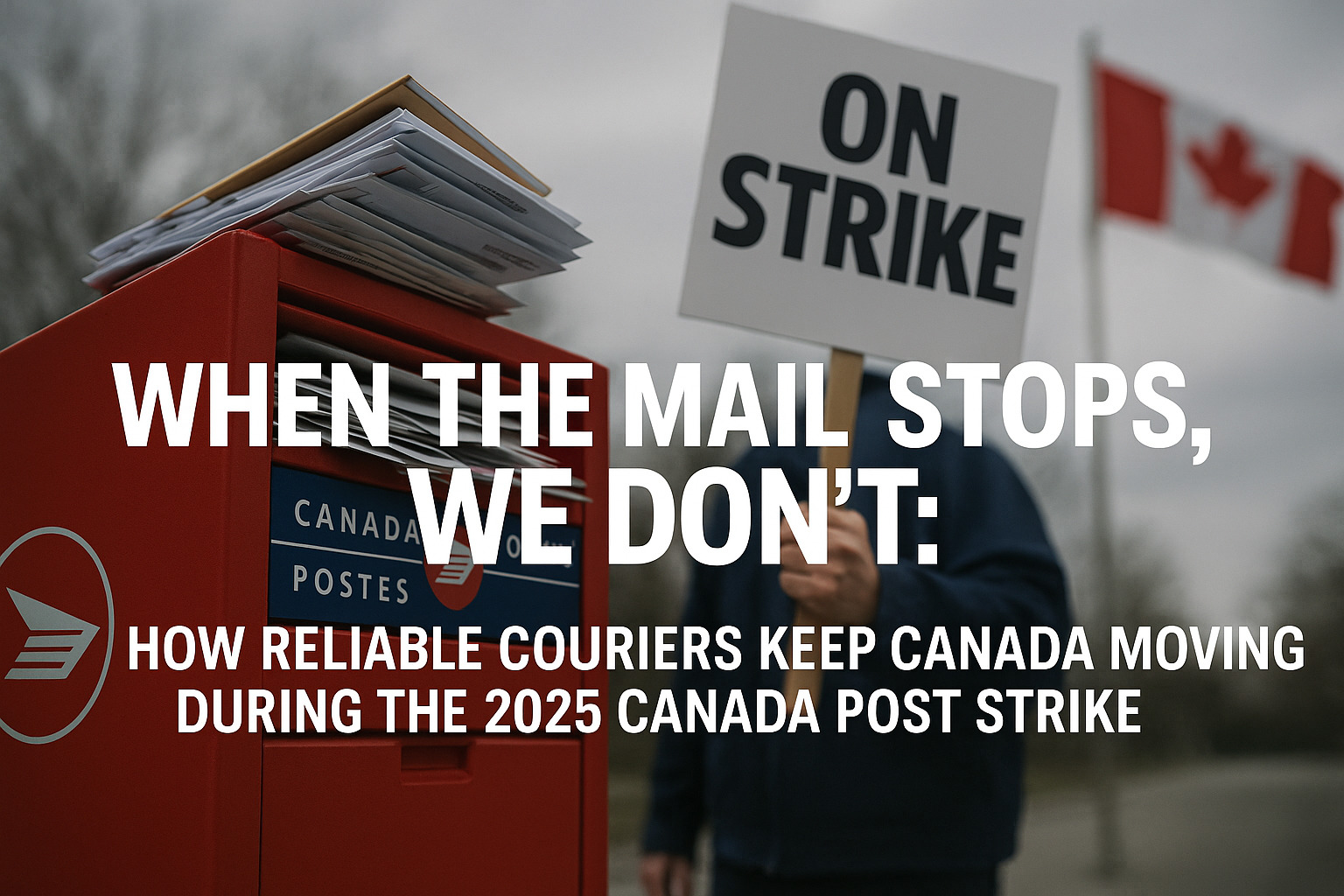
Canada’s delivery network is being tested again. This Canada Post strike isn’t just another labour dispute, it’s a national stress test for how we move critical information, goods, and lives across the country.
For most Canadians, this disruption means delays, uncertainty, and inboxes full of tracking numbers that no longer work. For us, it means something different. It means moving forward while others pause.
What Sparked the 2025 Canada Post Strike
On September 25, 2025, the Canadian Union of Postal Workers (CUPW) initiated a nationwide strike after talks with the federal government collapsed. According to the official statement from Canada Post, the walkout caused an immediate suspension of all regular mail and parcel services across the country.
The strike came just hours after the federal government announced sweeping reforms to the postal service. Reforms that would end door-to-door delivery for millions of Canadians, convert many addresses to community mailboxes, and close rural post offices that had served as lifelines in remote areas. You can read the full coverage of these reforms from The Independent.
The government’s argument was simple: Canada Post, as currently structured, was financially unsustainable. Prime Minister Mark Carney stated that the service was “not viable without modernization,” as reported by Global News.
CUPW, however, viewed the reforms as an attack on both workers and the public. They accused Ottawa of bypassing meaningful bargaining and undermining essential services, particularly in Indigenous, northern, and rural communities. A claim detailed by Global News and the union’s own official statement.
What’s Happening on the Ground
The 2025 strike involves more than 55,000 postal workers across Canada, according to ABC News.
Every province and territory is affected. AP News confirmed that all mail processing and parcel operations have been suspended, including business pickups, cross-border shipping, and government correspondence.
In cities like Toronto, Montreal, and Vancouver, postal depots have been picketed. Reuters documented daily demonstrations, with CUPW leaders calling it a “National Day of Action” to protest reforms and rally public support.
Even as negotiations stall, the government has refused to halt implementation of the new delivery model, arguing that automation, consolidation, and “postal modernization” are nonnegotiable. Value Added Resource reported that the reforms are being framed as a matter of financial survival rather than political choice.
What It Means for Canadians
When the mail stops, it’s not just about missing letters. It’s about what those letters represent.
- Healthcare systems depend on reliable specimen transport and medical supply delivery.
- Legal and financial firms depend on same-day filings, approvals, and contracts.
- Individuals rely on timely deliveries of prescriptions, tax documents, and government correspondence.
Now, all of those systems are at risk. Even the Canada Revenue Agency has warned of potential service disruptions due to the strike.
Once a national postal network halts, restarting it isn’t immediate. Canada Post has already suspended service guarantees, warning that backlogs could persist for weeks after the strike ends.
How We Responded at R Courier
We’ve always built our network with one question in mind: what happens when the system stops? The answer has always been the same: we move.
Within hours of the strike announcement, our team adjusted operations across Ontario and beyond. We restructured delivery zones, expanded driver schedules, and added real-time capacity to absorb new clients stranded by postal delays.
For healthcare partners, our medical courier network continued without interruption. We doubled routing frequency for hospital deliveries and accelerated our cross-provincial specimen transfer lanes.
For businesses, our time-sensitive delivery services became the fallback for contracts, filings, and approvals that couldn’t afford to sit idle. We’ve been quietly doing this for decades, handling urgent materials when larger systems go dark.
Reliability is not something we promise. It’s something we operationalize. Our clients don’t need to ask whether a strike affects them. It doesn’t.
The Technology That Keeps Us Moving
Reliability is built on transparency.
While large networks pause, our technology keeps information visible down to the minute.
Clients track every parcel, document, and specimen in real time through our reliability and tracking tools.
We maintain a balance between automation and accountability: algorithms route, but humans verify. It’s why our deliveries remain consistent, even when traffic, weather, or politics intervene.
Reliability isn’t about scale. It’s about trust.
The Strain on Businesses Across Canada
For small and medium-sized businesses, the strike isn’t just an inconvenience. It’s a revenue threat.
When invoices don’t arrive, payments don’t clear. When shipments stall, supply chains seize up. And when clients can’t get what they paid for, trust begins to erode.
That’s why we’ve seen a dramatic rise in local search activity for “courier services near me,” “delivery alternatives Canada,” and “courier Toronto.”
People aren’t waiting anymore. They’re looking for the next best system, one that doesn’t depend on bureaucracy.
This is where private courier networks step in, bridging the gap between national paralysis and local urgency.
Our services overview outlines how we handle critical deliveries that can’t wait for a labour resolution.
The Impact on Everyday Canadians
Not every delivery is about business. Some are personal. A medication refill, a university transcript, a care package.
In rural and northern communities, where the reforms hit hardest, this strike has left residents without essential access to mail. CUPW has argued that these closures represent a “quiet removal” of service equity across Canada.
Couriers are filling that void. We’ve expanded regional service routes to smaller towns and ensured that essential goods (from prescriptions to diagnostic materials) continue to move.
Reliability isn’t limited by postal codes. It’s shaped by commitment.
What Businesses Should Be Doing Right Now
A strike like this isn’t just a news headline. It’s a case study in dependency.
If your business depends on mail, it’s time to build redundancy into your logistics plan.
Here’s how:
- Identify critical items that can’t wait — contracts, invoices, or lab materials.
- Switch to verified couriers with clear tracking and same-day capacity.
- Batch non-urgent items for efficiency during high-demand periods.
- Communicate with clients and partners about alternate delivery methods.
- Review your contracts for flexibility in delivery obligations.
By building resilience now, businesses avoid scrambling later. And that’s not just smart logistics. It’s survival.
The Growing Demand for Reliable Couriers
Every time a strike like this happens, we see the same outcome: once clients experience a professional courier service, they rarely go back to waiting.
Reliability becomes addictive. Transparency becomes expected.
That’s why we’re scaling responsibly, hiring and training new couriers across Ontario. If you value accountability and want to build a career in logistics that actually matters, explore our career opportunities.
This industry is growing, and for good reason. It’s not just about moving packages. It’s about keeping systems functional when institutions falter.
What the Strike Reveals About Canada’s Future
The 2025 strike isn’t just about pay or reform. It’s about infrastructure fragility.
Canada is learning that it can’t depend on a single centralized system for something as fundamental as delivery.
As Reuters put it, this strike marks “the most significant disruption in national mail since 2018.” And yet, life goes on — because smaller, faster, and more agile networks step in.
The future of delivery in Canada will not be built on nostalgia. It will be built on performance. Where postal systems reform under pressure, couriers like us expand under necessity.
Local Reliability Beats National Delay
Toronto has become the heart of alternative delivery during this strike. Businesses that once relied entirely on Canada Post have shifted to private networks: law firms, medical labs, and even independent retailers are adopting direct courier systems.
That’s not a coincidence. Local is faster. Local is personal. Local doesn’t stop when the rest of the country does.
Our Toronto routes have tripled in activity since September. And yet, every delivery still gets the same individual accountability it always has. That’s the difference between a courier service and a postal service.
One is managed by policy. The other by purpose.
Preparing for What Comes Next
When the strike eventually ends, it won’t end neatly. The backlog will linger. Some reforms will stay. And public trust will take longer to rebuild than delivery routes.
That’s the moment when many Canadians will ask themselves whether they want to go back. Whether “normal” is worth waiting for.
We already know our answer. We’ll keep moving. For our healthcare clients, for our business partners, and for everyone who expects better.
If you need a courier you can depend on while the rest of the country waits, contact us. We’ll make sure what matters gets where it needs to go.






